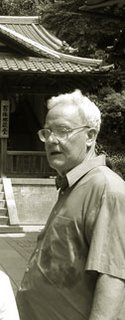
"WE KEEP ON DISCOVERING NEW THINGS FROM THE PAST, AND CURRENT TRENDS OF TRYING TO BREAK UP HISTORY INTO THESE STUPID BOMBASTIC ADVERTISER-TYPE TIMELINES (E.G."POST-COLD WAR this", "POST-WW II that", "POST-9/11 this") SERVES NOTHING BUT TO OBSTRUCT OUR EFFORTS IN UNDERSTANDING HOW GLOBALIZATION OPERATES"
I just stumbled upon old notes I took from a talk that Prof. Benedict R. O'G Anderson gave last year at the Center for Southeast Asian Studies (CSEAS), Kyoto University. Not intending to litter this blog with overtly indigestible academic stuff, it's nonetheless very stimulating...a critical and reflective talk that doesn't take 'globalisation' as we know it, for granted.
To the uninformed, Benedict Anderson authored the influential book "Imagined Communities: Reflections on the Origin and Spread of Nationalism" back in 1983. He is known in Indonesia for having co-authored "A Preliminary Analysis of the October 1 1965 Coup in Indonesia" (1966 - popularly known as "The Cornell Papers"), which concluded that the Indonesian Army (hence, Suharto) had prior knowledge to the events. For this, he was banned from visiting Indonesia by Suharto's New Order regime from 1966 to 1998 (including physical humiliation at Halim airport in 1981 when he was lured by Indonesian authorities to attend a seminar in Jakarta)
=================
CSEAS Talk - 27 April 2005
Topic: 'Macam Macam' (BA's own words)
"Twenty two years have passed since I wrote Imagined Communities...it has been quoted, praised and criticized over the years, and I've come to a certain point where I feel I have lost ownership of it. Imagined Communities is just like a little girl that has grown up and ran away to marry a truck driver from somewhere...I have now relinquished any left responsibilities over her..."
"I have my own share of criticisms aginst Imagined Communities. I treated 'Nationalisms' as separate and fixed analytical units..and that is the disadvantage if one attempts to undertake a comparative study. It's just like I've looked at the stars, and I could only go as far as commenting "oh, that's a bright star", "that's a little star"....Imagined Communities went as far as recognizing the main threads, the similarities or differences of these nationalisms, such as the role of print capitalism, colonial education, ....but back then, in my own naivete, i wasn't able to capture the larger interrelationships, or the larger forces of gravity that gave rise to these nationalisms."
"This is exactly the point which I'm intending to return to, and I will start by seeking explanations to the following question:
"What was the global field of gravity that gave birth to all these nationalisms - or what was the global field of gravity in which these nationalisms were able to operate during their initial stages ?"
"This brought me back to the question of rethinking the crucial elements of early 'globalization' that occurred during the latter half of the 19th century (1870 - 1900), in my opinion one of the most interesting periods in history. Two inventions were crucial in the birth of early globalization:
1) The invention of fast, cheap & safe modes of travel - the railway, the steamship: the sudden mass movements of people, the increased flow of ideas
2) Instant modes of communication - the telegraph: news about revolts and revolutions were instantly transmitted around the world...experiences of people in different parts of the world became instantly and vividly accessible...."
"We can look at all these revolution and nationalist movements around the world during that time as operating within a covert sub-global structure...waging covert projects through the technological advantages of early global communications, and in many ways, it renders my previous East-West model (the idea of Western nationalism being copied by post-colonial subjects) irrelevant. (DL: think of Chatterjee ?) Some nationalist movements in Asia and the Americas even preceded nationalist movements in Europe, e.g. Filipino nationalism is way much older than, let's say, Irish or Scottish nationalisms."
"Also, we have to situate this sudden outbreak of revolutions and nationalisms around the world within the vacuum period in the left-wing camp, that is the period between the death of Marx (1883) and the rise of Lenin to celebrity status in the 1920s. The Left during this vacuum was dominated by the Anarchists, particularly those based in France & Italy. These small bands of anarchists were involved all around the world, overthrowing & assassinating kings, dictators, reactionaries (e.g. Austria, Montenegro, etc). In many cases, these militant anarchists were the first 'suicide bombers'. This, coupled with rapid development of the global press (+ the invention of photo-relaying techniques), suddenly placed the anarchists in celebre spotlights around the world - inspiring oppressed peoples as far as Asia and the Americas, with ideas that revolutions (& violence) are viable alternatives to social change."
"The international postal-service, intiated in 1874, was also one way through which anarchist ideas about revolution were disseminated. As early as the late 1890s, French anarchist newsletters had permanent subscribers in more than 20 countries around the world, spanning from Europe to East Asia to Latin America."
"The revolution in the Philippines, the oldest nationalist movement in Asia, itself inspired by creole revolutions waged in the Carribean states (Cuba), inspired the birth of the Chinese nationalist movement against the Manchus...so again, this all wouldn't be possible without the existence of a global communication system. We also have to look at the itinerant characters behind it. Jose Rizal travelled to Japan, coming in contact with early Chinese nationalists, and heading afterwards towards Europe through the US. This was all made possible by fast & cheap transportation (the steamship). This was way before the era of Tan Malaka or Ho Chi Minh, both who were itinerant characters as well."
"We keep on discovering new things about the past, and the current trend of trying to break up history into these stupid bombastic advertiser-type timelines (e.g. 'post-WW II', 'post-9/11', 'post-Cold War') serves nothing but to obstruct our efforts in understanding how globalization operates."
"This will be among others the focus of my forthcoming book."
=============
(DL: "Under Three Flags: Anarchism and the Anti-Colonial Imagination" - was published in Jan. 2006 by Verso)

 The federal division of Belgium (België/Belgique), reflecting the linguistic division of Dutch-speaking Vlaanderen state and French-speaking Wallonie
The federal division of Belgium (België/Belgique), reflecting the linguistic division of Dutch-speaking Vlaanderen state and French-speaking Wallonie The linguistic divide: Flemish Brabant and Wallon Brabant
The linguistic divide: Flemish Brabant and Wallon Brabant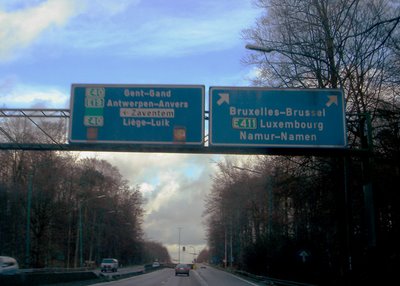 Bilingual Brussel: roadsigns with both Dutch and French versions of placenames
Bilingual Brussel: roadsigns with both Dutch and French versions of placenames Echoes of 1968 anarchism in old Leuven/Louvain: "Don't Vote, Think for Yourself"
Echoes of 1968 anarchism in old Leuven/Louvain: "Don't Vote, Think for Yourself" No trace of Dutch language 10 meters within Wallonie, the northernmost frontier of the Francophone world (Senegal being perhaps its southernmost border)
No trace of Dutch language 10 meters within Wallonie, the northernmost frontier of the Francophone world (Senegal being perhaps its southernmost border) St. Pieter's Leeuw: A rustic small town, but linguistically militant
St. Pieter's Leeuw: A rustic small town, but linguistically militant Wallon politicalinguistic correctness: Flemish Halle changed into it's 'correct' French name, only 20 meters before the linguistic border
Wallon politicalinguistic correctness: Flemish Halle changed into it's 'correct' French name, only 20 meters before the linguistic border Belgian Nationalism: nevermind the language mess, it's in the Frites !!
Belgian Nationalism: nevermind the language mess, it's in the Frites !!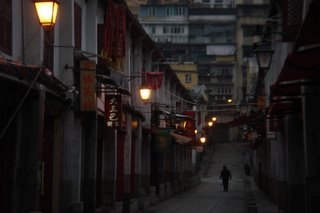 Macau dawn at Rua da Felicidade
Macau dawn at Rua da Felicidade
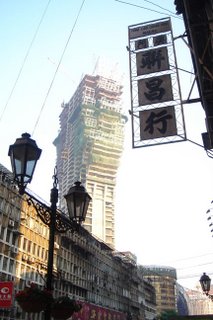
 A Pinoy ad....and problem.
A Pinoy ad....and problem. Signs of Indon presence in Macau
Signs of Indon presence in Macau Echoes of Dear Chairman, once influential in Macau during the 1960s
Echoes of Dear Chairman, once influential in Macau during the 1960s Remains of the DDR border viewed from Hanstein Castle, Bornhagen,Thüringen
Remains of the DDR border viewed from Hanstein Castle, Bornhagen,Thüringen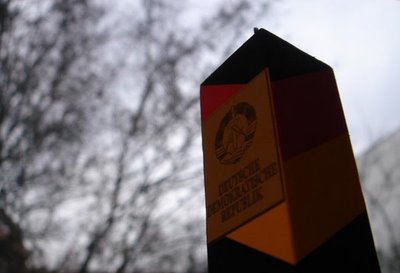 DDR Borderpoles
DDR Borderpoles A border memorial stone erected near Bornhagen, littered with some recent pro-DDR grafitti
A border memorial stone erected near Bornhagen, littered with some recent pro-DDR grafitti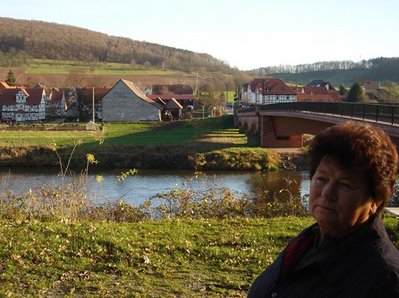 Gerlinde (69) looking across to Lindewerra, where the Werra river previoulsy separated the DDR from BRD
Gerlinde (69) looking across to Lindewerra, where the Werra river previoulsy separated the DDR from BRD The intact border fence at Schifflersgrund
The intact border fence at Schifflersgrund Willi Stüber (79) remembers
Willi Stüber (79) remembers Tivai Ngang, Punan Busang headman of Long Unai
Tivai Ngang, Punan Busang headman of Long Unai The Upper Balui
The Upper Balui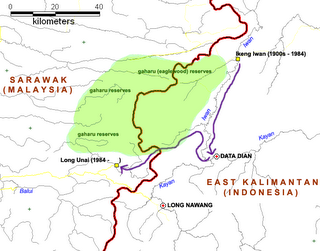 Punan Busang Migration map from Long Ikeng Iwan (Indonesia) to Long Unai (Malaysia)
Punan Busang Migration map from Long Ikeng Iwan (Indonesia) to Long Unai (Malaysia)




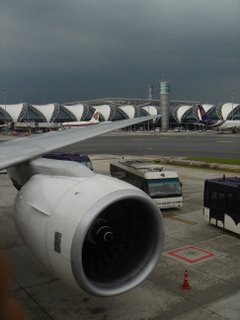



 "Please do not pour soy sauce directly from the bottle. Please use the brush."
"Please do not pour soy sauce directly from the bottle. Please use the brush."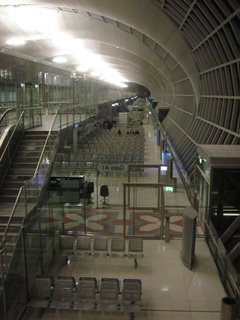 Suvarnabhumi's boarding gates
Suvarnabhumi's boarding gates Cold demeaning steel
Cold demeaning steel Suvarnabhumi's displays of light
Suvarnabhumi's displays of light One of the few operational Smoking rooms
One of the few operational Smoking rooms Japanese Mild Sevens & Marlboros, Korean-made Esses & Salems
Japanese Mild Sevens & Marlboros, Korean-made Esses & Salems Apai Regang is expected to download a permit in PDF form if he wants to see his cock fight
Apai Regang is expected to download a permit in PDF form if he wants to see his cock fight  Map Kapit Division in Sarawak
Map Kapit Division in Sarawak




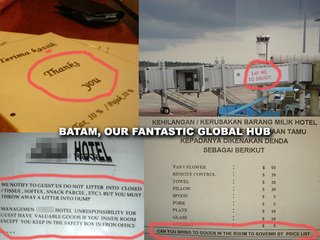 Global, not quite...
Global, not quite... Hang Nadim Airport: Counter for Job Seekers. Is the system running at all?
Hang Nadim Airport: Counter for Job Seekers. Is the system running at all? A peek outside the hotel: Disposed tissues, cigarette packs, condoms. Helps in profiling your average Batam visitor...
A peek outside the hotel: Disposed tissues, cigarette packs, condoms. Helps in profiling your average Batam visitor...